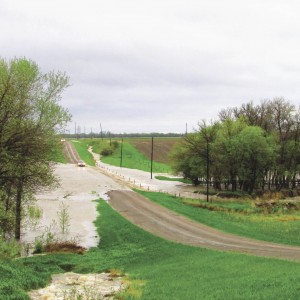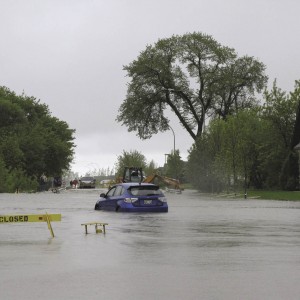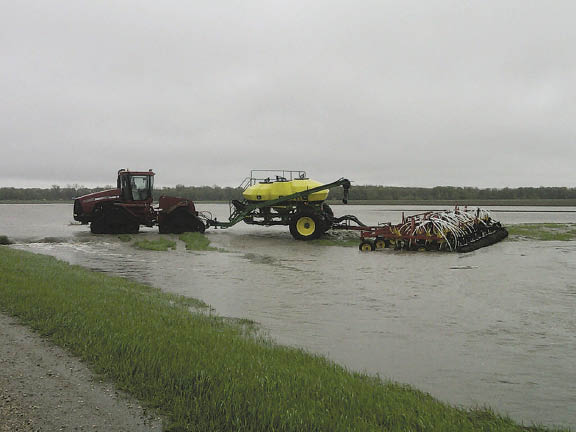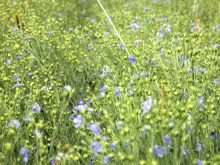

 Two heavy dumps of rain within a week of each other in south-central Manitoba caused widespread overland flooding and put seeding on hold.
Two heavy dumps of rain within a week of each other in south-central Manitoba caused widespread overland flooding and put seeding on hold.
Read Also

Mazergroup’s Bob Mazer dies
Mazergroup’s Bob Mazer, who helped grow his family’s company into a string of farm equipment dealerships and the main dealer for New Holland machinery in Saskatchewan and Manitoba, died July 6 from cancer.
Farmers in the Miami, Darlingford and Thornhill areas are now praying for warm, dry, windy weather but at press time June 3 the forecast was for more showers by the weekend.
Official rainfall amounts varied from three to 4.8 inches. But when combined with the earlier rain some areas have had up to 13 inches or more than half a whole year’s worth of precipitation.
Like the amount of rain that fell, the number of acres left to seed varies widely. South of Thornhill many farmers weren’t half done, said Kelvin Rothenburger in an interview June 3. His farm received three inches May 30 and 31, but was hammered with eight inches the May long weekend. He said some farmers received 10 inches that weekend.
At best, on average, two-thirds of seeding has been completed in the Darlingford area, estimates local seed grower Jim Wilson.
“When I look at some of the bigger operations they aren’t very far along,” he said. “Some would be less than half or even a quarter in some cases. But then there are others that are three-quarters or more seeded.”
Progress is even more delayed north of Manitou, he added.
Farmers were calling Wilson earlier this week to discuss changing their seeding plans. June 4 was the extended seeding deadline for soybeans in Soybean Area 2.
“There are a lot of acres of soys that haven’t gone in from this general area,” he said.
This was the third time water has run off fields in the region this year. The first was the spring snowmelt. Fears of downstream flooding disappeared as much of the meltwater soaked in or evaporated. Soils were generally dry following a hot, dry summer and fall.
The second was after the rain that fell on the long weekend. That run-off exceeded the spring melt.
Last week’s run-off was the biggest so far. And the most dramatic.
“We had water higher on the roads and more damage than we had in either the (spring) run-off or the big rain,” Wilson said.
Parts of Morden were flooded when the Dead Horse Creek spilled its banks.
Longtime residents along the Tobacco Creek near Miami said they’d never seen the creek so high, or so threatening where it jumped its banks.
Less than 24 hours after the rain there were acres of land under water. In-field and municipal drainage might have played a role in the overland flooding, said Andy Nadler, an agricultural meteorologist, with Weather Innovations.
“I live on the Dead Horse Creek (west of Morden) and once it starts raining it’s within hours that the levels start going up,” he said. “I think even 20 years ago when it (drainage) was less precise, but especially 50 or 75 years ago, it would’ve been totally different because the potholes and the sloughs would catch the water. It would’ve taken days or even weeks for water to get into the creek but now everything is so excellently drained, which is good for getting it off the fields, but for water managers, it goes in there so fast.”
Areas in southern Manitoba that have saturated soil could be running up against crop insurance deadlines. The crop insurance deadline for seeding canola in (Area 1) is June 15 with full coverage and June 20 with reduced coverage.The deadline for seeding wheat province-wide is June 20.
A record 3.1 million acres of land — almost a third of the acres normally planted to annual crops — didn’t get seeded in 2011 because it was too wet.
Thousands more acres were “mudded in,” “floated on” or seeded by airplane. (Crop insurance no longer insures crops seeded by air.)
That same year 501,800 acres received payments from the Manitoba Excess Moisture Assistance.




















